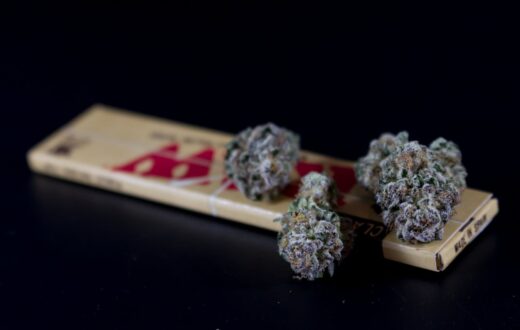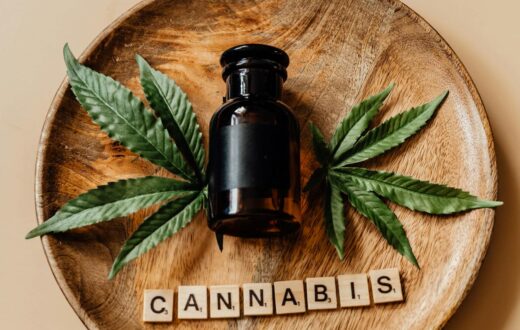Introduction to Blueberry Headband Strain
The Blueberry Headband strain is a unique hybrid cannabis variety that boasts a flavorful profile and robust effects, making it a popular choice among both novice and seasoned growers. This strain combines the genetics of the famed Blueberry and Headband strains, resulting in a well-balanced profile that delivers both indica and sativa characteristics. Originating from a rich lineage, Blueberry Headband inherits the fruity, sweet aromas of Blueberry while adopting the earthy, diesel notes from the Headband, creating a complex flavor experience that pleases the palate.
In terms of genetic makeup, Blueberry Headband is classified as a 70/30 indica-dominant strain, which contributes to its soothing and euphoric effects. This particular strain is known for its enticing hues of deep blue and purple, accompanied by vibrant green foliage, making it aesthetically pleasing as well. Growers will appreciate its high-yield potential, which is enhanced by its ability to thrive in various growing conditions, making it accessible for outdoor and indoor cultivation alike. The plant typically reaches a medium height, allowing it to fit comfortably in smaller grow spaces.
Moreover, Blueberry Headband is often sought after for its resilience, showing adaptability to different climates and resistance to common pests and diseases. These characteristics not only make it favored among growers looking to maximize their yield but also enhance its significance within the cannabis cultivation community. As interest in high-yield strains continues to grow, understanding how to grow Blueberry Headband strain can provide valuable insights for those looking to cultivate this exceptional variety. As growers delve into the processes of nurturing this strain, its unique qualities and potential for high outputs will surely capture their attention.
Ideal Growing Conditions
To successfully cultivate the Blueberry Headband strain, it is crucial to replicate its natural habitat by providing optimal environmental conditions. This strain thrives in a controlled environment, where various factors such as temperature, humidity, light cycles, and soil composition play a pivotal role in achieving robust growth and maximizing yield.
Temperature is a significant aspect to consider when learning how to grow Blueberry Headband strain. Ideally, this strain prefers daytime temperatures ranging from 70°F to 80°F (21°C to 27°C) and slightly cooler nighttime temperatures between 60°F and 70°F (16°C to 21°C). Maintaining these temperatures helps stimulate healthy growth while preventing stress that could hinder development.
Humidity levels should be carefully monitored as well, particularly during different growth stages. For the vegetative stage, a humidity level of around 50% to 70% is ideal, while the flowering stage ideally maintains a lower humidity level of 40% to 50%. This reduction helps minimize the risk of mold and mildew, which can be detrimental to the plant’s health.
Light cycles are another essential factor, as Blueberry Headband requires a stable light environment to thrive. During the vegetative phase, a light cycle of 18 hours on and 6 hours off is recommended. Once the plants transition to the flowering stage, altering the light cycle to 12 hours on and 12 hours off will encourage the development of flowers and maximize yield.
Finally, adequate soil composition is vital for achieving optimal growth. The Blueberry Headband strain flourishes in well-draining soil rich in organic matter. Utilizing a blend of peat moss, perlite, and compost will give it the necessary nutrients and drainage required for healthy root development. By ensuring these ideal growing conditions, cultivators can expect a fruitful harvest of the Blueberry Headband strain.
Nutrient Requirements
The cultivation of the Blueberry Headband strain necessitates a keen understanding of its nutrient requirements throughout its growth cycle. This strain, known for its rich flavor profile and potent effects, has specific needs for macronutrients and micronutrients that are critical during its vegetative and flowering stages.
During the vegetative stage, Blueberry Headband plants require a balanced nutrient mix rich in nitrogen, phosphorus, and potassium (N-P-K). Nitrogen is particularly important as it promotes healthy foliage development. A fertilizer with a higher nitrogen ratio will support the growth of robust, green leaves. As the plants approach flowering, the ratios should shift; a nutrient mix with increased phosphorus and potassium will encourage blooming and fruit set. It is advisable to select specialized fertilizers that cater to these shifts, such as those explicitly designed for cannabis plants or high-nitrogen fertilizers followed by those with higher phosphorus and potassium content.
Micronutrients also play a vital role in the healthy growth of Blueberry Headband. Essential elements such as calcium, magnesium, and iron contribute to overall plant health and should not be overlooked. Regularly monitoring pH levels in the soil or hydroponic solutions ensures that these micronutrients are available for absorption. The optimal pH range for Blueberry Headband typically falls between 6.0 and 6.8, which allows for the most effective nutrient uptake.
In addition to synthetic fertilizers, organic options such as fish emulsion or seaweed extract can enhance soil health and foster a more sustainable growing environment. Utilizing organic nutrients can help to enhance the flavor and potency of the final product. Therefore, as you learn how to grow the Blueberry Headband strain, providing targeted nutrition at each growth stage is crucial for achieving healthy plants and maximizing yield.
Propagation Methods
When considering how to grow Blueberry Headband strain, it is essential to explore various propagation methods available to ensure successful growth and development. The primary methods for propagating this strain include seeds, clones, and cuttings. Each of these methods has its advantages and disadvantages, which can significantly impact the overall growth and yield of the plants.
Starting with seeds, this method allows for genetic diversity and the potential for creating unique phenotypes. To propagate Blueberry Headband from seeds, one must first acquire high-quality seeds from a reliable source. The germination process begins by soaking the seeds in water for 24 hours, followed by planting them in a moist seed-starting mix. Once germinated, the seedlings require adequate light, warmth, and nutrients to grow into healthy plants. However, growing from seeds may often result in variations in traits, which may not necessarily match the parent plant.
Alternatively, cloning is a popular propagation method that ensures the exact replication of the parent plant’s characteristics. To clone Blueberry Headband, identify a healthy mother plant and select a suitable branch. Cut a 6-8 inch segment just below a leaf node, and remove excess foliage. Placing this cutting in a glass of water or directly in a cloning medium will develop roots over time. Cloning offers the advantage of preserving desired traits and significantly reduces the time required to produce mature plants. However, it may sometimes lead to a decrease in genetic vigor over successive generations.
Lastly, using cuttings is a straightforward approach as well. Similar to cloning, this method involves taking cuttings from a healthy mother plant. After preparing the cuttings, applying rooting hormone can accelerate root development. This method is beneficial for gardeners who seek consistent results, although it requires careful handling to prevent disease transmission. Each method of propagation with Blueberry Headband strain presents unique benefits, therefore, evaluating your specific goals will guide you toward the most suitable option.
Watering Techniques
Watering is a crucial aspect of successfully cultivating the Blueberry Headband strain. Understanding the preferred moisture levels and how to maintain them is essential for the overall health of the plants. For Blueberry Headband, soil moisture should be kept consistently damp, but not saturated. This balance is key in preventing common issues such as root rot that can arise from over-watering.
The frequency of watering largely depends on various factors including the plant’s growth stage, environmental conditions, and the specific growing medium used. During the vegetative stage, these plants may require watering every few days. However, as they transition into the flowering phase, the frequency might decrease slightly, as the water uptake patterns change. It is advisable to check the top one inch of the soil; if it feels dry to the touch, it is time for another watering.
Using proper watering methods can also enhance the growing process. Drip irrigation systems are an excellent option for Blueberry Headband growers, as they provide a slow and steady water supply directly to the roots. This minimizes water wastage and reduces the risk of leaf wetness, which can lead to fungal diseases. Additionally, utilizing moist trays or bottom watering can help in evenly distributing moisture throughout the soil, which is particularly effective in larger containers.
To avoid over or under-watering, growers should observe plants for signs of stress. Wilting leaves may indicate a lack of moisture, while yellowing leaves can hint at over-saturation. Ultimately, understanding how to grow Blueberry Headband strain hinges significantly on the watering techniques employed, emphasizing the importance of monitoring and adjusting as necessary to achieve optimal growth.
Pest and Disease Management
Effective management of pests and diseases is crucial for cultivating the Blueberry Headband strain, as these factors can significantly impact yield and overall plant health. Common pests that may afflict this strain include aphids, spider mites, and whiteflies. Early detection is paramount; growers should regularly inspect their plants for any unusual signs of distress, such as discolored leaves or webbing. Moreover, yellowing of foliage can indicate aphid infestation, while fine webs may suggest spider mites are present.
To prevent these pests, maintaining a clean growing environment and ensuring proper air circulation can minimize the risk of infestation. Utilizing companion planting strategies, such as incorporating beneficial insects like ladybugs, can also help control pest populations naturally. If pest issues arise, organic insecticidal soaps or neem oil can serve as effective treatments. These solutions target the pests without damaging the Blueberry Headband plants, ensuring the integrity of the crop is preserved.
Additionally, diseases such as powdery mildew and root rot can jeopardize the growth of Blueberry Headband. Powdery mildew is often identified by a dusty, white coating on the leaves, while root rot is usually preceded by a yellowing of the leaves and stunted growth. To combat these diseases, it is essential to provide adequate air circulation to minimize humidity around the plants and avoid overwatering, which can exacerbate conditions conducive to root rot.
Employing a regular monitoring routine will not only aid in the early detection of these pests and diseases but also facilitate timely interventions. In conclusion, understanding how to grow Blueberry Headband strain successfully includes implementing robust pest and disease management practices to safeguard plants during their developmental stages.
Harvesting Techniques
Successfully harvesting the Blueberry Headband strain requires keen observation and precise timing. Generally, the optimal window for harvesting occurs when the majority of the trichomes appear cloudy, with a ratio of about 10-20% turning amber. These indicators signify peak levels of cannabinoids, ensuring the highest quality buds. Additionally, the pistils will typically change color from white to a darker hue, further indicating readiness. Regularly inspecting your plants in the days leading up to anticipated harvest can ensure you don’t miss this crucial window.
Before commencing the harvest, it is essential to gather the proper tools to ensure efficiency and maintain the quality of the cannabis. A sharp pair of pruning shears or scissors is crucial for clean cuts, minimizing stress on the plants which can affect future growth potential. A pair of gloves is recommended to avoid contaminating resinous buds, preserving their potency and flavor profile. It is also wise to have bags or containers ready to collect the harvested branches, allowing for an organized process.
Post-harvest handling plays a critical role in maintaining the quality of your Blueberry Headband buds. After cutting the branches, hang them upside down in a dark, cool area with low humidity for about 7-14 days. This method allows for an optimal drying process, ensuring cannabinoids and terpenes remain intact, enhancing flavor and potency. Once dried, trimming excess leaves and packaging the buds in airtight containers will further aid in preserving freshness. Checking the humidity levels within the storage containers is important to prevent mold while ensuring your Blueberry Headband strain remains at its best quality. Utilizing these techniques will not only enhance your yield but also ensure a superior final product.
Troubleshooting Common Problems
Growing the Blueberry Headband strain can be rewarding, yet it comes with its own set of challenges. Understanding common issues and their solutions will help ensure a successful cultivation process. One major problem growers often face is stunted growth. This can result from inadequate light exposure or poor soil conditions. To resolve this, ensure your plants receive sufficient sunlight or artificial grow lights, and use high-quality, well-draining soil enriched with organic matter.
Nutrient deficiencies are another frequent issue when cultivating Blueberry Headband. Common signs include yellowing leaves and poor bud development. This strain thrives on a balanced nutrient regimen, particularly during its flowering phase. Consider using a nutrient-rich fertilizer specifically formulated for cannabis, making sure to follow the recommended dosage to avoid over-fertilization—which can cause nutrient burn. Regular soil testing can also help identify deficiencies early on, allowing for timely interventions.
Environmental stress can significantly impact the growth and yield of the Blueberry Headband strain. Factors such as incorrect temperature, humidity, and airflow can lead to problems like mildew or pest infestations. Ideally, maintain daytime temperatures between 70°F and 80°F and humidity levels around 40% to 60% during vegetative growth. Utilizing fans or humidifiers can improve airflow and regulate humidity levels effectively. Frequent monitoring of your growing environment will help you catch and address any discrepancies promptly.
In addition to these factors, it is crucial to remain vigilant for pests such as spider mites and aphids. Applying organic pest control methods or introducing beneficial insects can help keep these unwelcome guests at bay. Understanding how to grow the Blueberry Headband strain involves not only nurturing the plants but also being proactive about potential obstacles. This approach will ultimately lead to healthier plants and a better harvest.
Conclusion and Final Tips
To cultivate the Blueberry Headband strain successfully, understanding the specific requirements of this unique cannabis variety is essential. This strain is celebrated for its high yield and potent effects, making it a favorite among growers and users alike. Throughout this blog post, we’ve discussed various aspects of growing this strain, from selecting the right seeds to providing the optimal growing conditions.
One of the key takeaways is the importance of environmental control. Blueberry Headband thrives in conditions that mimic its native climate—warm temperatures, adequate humidity, and optimal light exposure. Choose the right lighting setup to ensure your plants receive sufficient light, particularly during the flowering stage, which is crucial for maximizing yield. Additionally, maintaining the appropriate pH levels and nutrient balance will significantly enhance growth and potency.
For novice growers, starting with feminized seeds can simplify the growing process and increase the likelihood of successful cultivation. With the right care and attention, even beginners can achieve impressive results. Experienced growers, on the other hand, can explore advanced growing techniques, such as topping and SCROG (Screen of Green), to enhance yield and quality further.
Lastly, patience and observation are vital. Monitor your plants closely, making adjustments as necessary while they progress through their growth stages. Harvesting at the right time can significantly impact flavor and potency, so be vigilant and informed about the signs of readiness.
In conclusion, by following these tips and understanding the nuances of how to grow the Blueberry Headband strain, both novice and seasoned growers can enjoy the fruits of their labor with high yields and a rich, flavorful harvest. Embrace the journey of cultivation and enjoy the process of bringing this exceptional strain to life.














